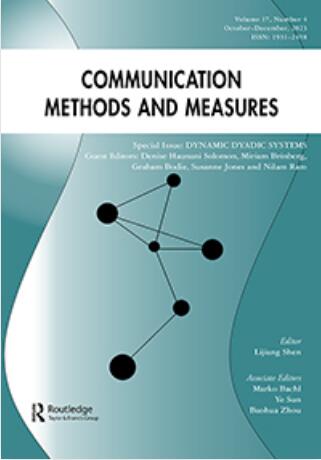老年人真的更聪明吗?识别年长和年轻约会伴侣的冲突沟通模式
IF 3.7
1区 文学
Q1 COMMUNICATION
引用次数: 1
摘要
本文章由计算机程序翻译,如有差异,请以英文原文为准。
Is Older Indeed Wiser? Identifying Conflict Communication Patterns in Older and Younger Dating Couples
ABSTRACT More adults are dating in later life, yet little is known regarding how older adults navigate conflict in their newly formed relationships. Given theories suggesting that older adults are especially skilled in minimizing negativity within their relationships, the current study utilized data from 81 dating couples (age range 30–88) to examine potential age differences in couples’ behavioral patterns during observed conflict discussions. Using sequence analysis, we identified four distinct multi-turn communication patterns, known as conversational motifs, which characterized couples’ discussions: oppositional problem-solving, cooperative problem-solving, positive passivism, and avoidance. Further analyses revealed no significant age differences in the prevalence of these motifs within couples’ conversations. However, age moderated the effect of oppositional problem-solving motifs on post-conversation appraisals for men. If couples engaged in more oppositional problem-solving sequences, younger, but not older, men rated the conversation as less satisfying. The implications of these findings for understanding age differences in communication are discussed.
求助全文
通过发布文献求助,成功后即可免费获取论文全文。
去求助
来源期刊

Communication Methods and Measures
COMMUNICATION-
CiteScore
21.10
自引率
1.80%
发文量
9
期刊介绍:
Communication Methods and Measures aims to achieve several goals in the field of communication research. Firstly, it aims to bring attention to and showcase developments in both qualitative and quantitative research methodologies to communication scholars. This journal serves as a platform for researchers across the field to discuss and disseminate methodological tools and approaches.
Additionally, Communication Methods and Measures seeks to improve research design and analysis practices by offering suggestions for improvement. It aims to introduce new methods of measurement that are valuable to communication scientists or enhance existing methods. The journal encourages submissions that focus on methods for enhancing research design and theory testing, employing both quantitative and qualitative approaches.
Furthermore, the journal is open to articles devoted to exploring the epistemological aspects relevant to communication research methodologies. It welcomes well-written manuscripts that demonstrate the use of methods and articles that highlight the advantages of lesser-known or newer methods over those traditionally used in communication.
In summary, Communication Methods and Measures strives to advance the field of communication research by showcasing and discussing innovative methodologies, improving research practices, and introducing new measurement methods.
 求助内容:
求助内容: 应助结果提醒方式:
应助结果提醒方式:


